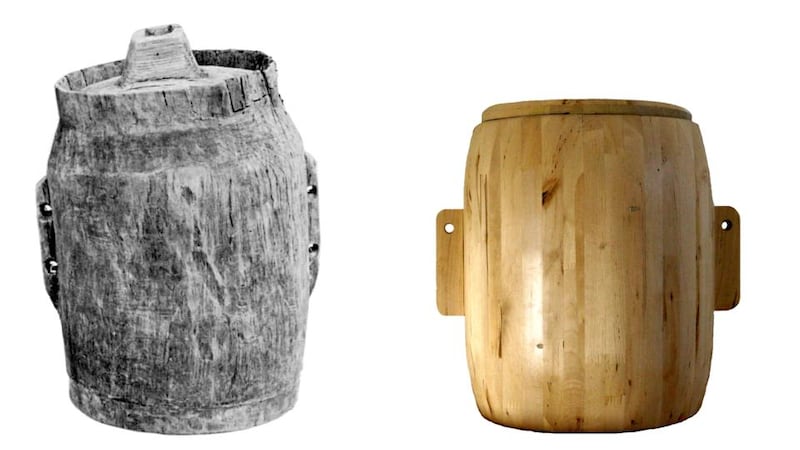Thicket – Anthony Lyttle
Cross Gallery, Dublin
****

Anthony Lyttle was born in Kisumu, Kenya, in 1960, but has spent most of his life in Ireland. He studied painting at NCAD and then, more recently, completed an MFA at Byam Shaw, Central St Martins, London. By then he was best known as a printmaker, having been a member of Blackchurch Print Studio from 1987. He lives in Co Carlow, and, appropriately enough, his benchmark exhibition, Accumulation, was held at Visual Centre for Contemporary Art in Carlow in 2012 as part of Éigse. His finely detailed work flourished in the huge space of Visual's main gallery.
It flourishes too in the Cross Gallery, where the mostly large pieces that make up his current show, Thicket, are installed. His works fall somewhere between painting and drawing, but lean more towards drawing. The densely patterned surfaces we encounter are cumulatively built up through the application of countless individual marks made on paper. It's a slow, methodical, iterative process. He has remarked that the lengthy rhythm of the mark-making informs the eventual appearance of the compositions.
They are intricate, all-over compositions and can superficially appear as thoroughly orderly and even, as though they are woven on a loom. Weaving is certainly a good analogy and point of reference, but the works are less mathematically precise than that, and more organic in feeling. They also have a curious, flickering quality that derives from the way they’re built up from the give and take of marks made and marks cancelled: black over white over black over white, to put it at its simplest. So they have an in-between, uncertain quality that slightly unsettles the eye but also keeps it continually interested.
In addressing this ambiguity in his essay for Accumulation, Brian Garvey memorably described them as visualising "breakdown events": moments "when one is on the borderline of fainting", for example, when one's normal grasp of things is on the point of dissolution or transformation. Yet their underlying agitation is smoothly contained by their cool, rhythmic structures. Temperamentally they are related to the work of Agnes Martin or Makiko Nakamura, who similarly embed vast reservoirs of feeling in beautiful, impassive surfaces: emotion recollected in tranquillity. Until February 28th, crossgallery.ie
The Pattern Exchange
Temple Bar Gallery, Dublin
****
The Pattern Exchange, curated by Rosie Lynch and Hollie Kearns, nods to Temple Bar Gallery's early history as a shirt factory. But they take the notion of a pattern well beyond its use in sewing and clothing manufacture. They seem to have in mind the evolution of Temple Bar as a living, urban quarter over time, an evolving site for various overlapping activities, different kinds of production and recreation.
Their use of the word "pattern" relates to an influential 1977 book on urban architecture, design and community, A Pattern Language. The book, idealistic and co-operative in spirit, proposed an alternative mode of planning and living, based on communal problem-solving and self-determination, and envisages communities as networks of concentric, interlocking and overlapping patterns. The 250-plus patterns that comprise the book range from utterly practical templates to more theoretical propositions.
Lynch and Kearns sought out artists who have track records in engaging with the communal context in one way or another, inviting them to show existing and perhaps ongoing works, and to take part in a live event, such as delivering a talk or introducing a screening, during the run of the show.
The one notable exception to pre-existing work was a commission. The unorthodox London-based architectural practice Studio Weave was enlisted to rework the gallery entrance; not to dismantle the doorway, but to rethink the space beyond it.
They have done rather well, counterintuitively introducing another, inner quasi-doorway, an open screen of tensile, coloured rope, creating an appealing intermediate space, one worth keeping. The ropes are also used in the gallery’s furniture, including the invigilator’s desk. If the rationale is weak – proximity to the docks, essentially, although the hand-dyed cotton also suggests textiles – the end result is clever, cheerful and effective.
In a similar spirit, Paul Bokslag's soaring paper cut-out, Resonance, is a gracefully buoyant sculpture that echoes the building's history, current use, and physical fabric – the atrium space within.
Sarah Browne shows a wonderful object not so much found as acquired, a Shetland Islands knitting belt. She traced it after being struck by photographs of Shetland women knitting as they carried baskets of turf. The knitting belt enabled a woman to fix one needle in place, freeing up one hand to hold the turf basket. Hand to Mouth, which will join the knitting belt on view in the gallery, "knits" copies of the photographs with collaged images of contemporary women multitasking. A blanked out clock-face, Zero Hour Contract, is an elegant symbol of the reality of subsistence economies for workers today.
Gareth Kennedy's Ikea Butter Churn for Gneeveguilla sees Ikea tables translated into a butter churn and firkin and buried in the bog, the first of his forays into Folk Fictions. Fiona McDonald's fascinating, ongoing project on Great South Wall in Dublin charts the shrinking public access to the 18th-century, 5.6km wall, a landmark engineering project and long a popular public walkway.
Sarah Lincoln's digital film is part of her wider exploration of the decline of the fishing industry around Ardmore, Co Waterford, although the point of her conflation of geological, industrial and recreational imagery remains vague.
Overall, The Pattern Exchange is a very good group show that doesn't quite fulfil its considerable potential.
Rosie Lynch discusses the works in the exhibition in relation to urban development in Dublin today at 5.30pm in the gallery. Details of an extensive programme of other related events are available online and on site.











